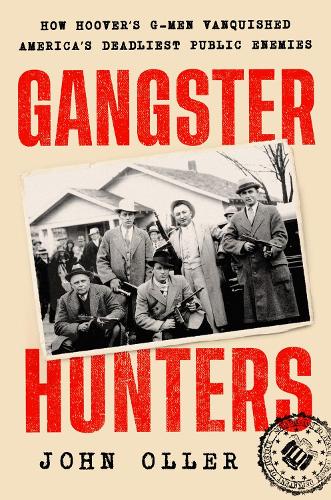
Gangster Hunters: How Hoover's G-Men Vanquished America's Deadliest Public Enemies
(Hardback)
Publishing Details
Gangster Hunters: How Hoover's G-Men Vanquished America's Deadliest Public Enemies
By (Author) John Oller
Penguin Putnam Inc
Dutton / Signet
7th January 2025
26th November 2024
United States
Classifications
General
Non Fiction
363.25097309
Physical Properties
Hardback
512
Width 160mm, Height 238mm
791g
Description
J. Edgar Hoover was the face of the FBI. But the federal agents in the field, relentlessly chasing the most notorious gangsters of the 1930s with their own lives on the line, truly transformed the Bureau. J. Edgar Hoover was the face of the FBI. But the federal agents in the field, relentlessly chasing the most notorious gangsters of the 1930s with their own lives on the line, truly transformed the Bureau. Gangster Hunters details the fascinating story of the birth of the modern FBI. In 1932, the FBI lacked jurisdiction over murder cases. It also could not pursue bank robberies or kidnappings, and it had no power of arrest. Relegated to the sidelines, the Bureau mostly investigated corporate wrongdoing, such as bank fraud and antitrust violations. Agents spent their days at their desks. But all of that changed during the War on Crime, which began in 1933 and lasted until 1936. Hunting down infamous public enemies in tense, frequently blood-soaked shootouts, the Bureau was thrust onto the front pages for the first time. Young agents, fresh out of law school and anticipating a quiet, white-collar job, faced off with murderous felons who were heavily armed, clad in bulletproof vests, and owned cars that outraced the best vehicles the Bureau had. But the federal men were fiercely devoted-to the Bureau, to each other, and to bringing America's most wanted criminals to justice. The G-men crisscrossed the United States in pursuit of the likes of John Dillinger, Bonnie and Clyde, Ma Barker's criminal family, Baby Face Nelson, and Pretty Boy Floyd. But they were always one step behind and a moment too late, the criminals slipping between their fingers and leaving bodies in their wake. Facing mounting criticism, the agents had to learn to adapt. After all, more than their reputations were at stake. John Oller transports readers right to the most harrowing and consequential raids of the 1930s, with fast-paced action that shows the lengths both sides would go to win.
Reviews
Ollers legendary cast of good guys and bad guys make for a rip-roaring read. Vivid, commanding, and thoroughly researched.
#1 New York Times bestselling author Martin Dugard, author of Taking London and Killing the Mob
"The War on Crime in the 1930s pitted a still-evolving FBI against criminals whose names still resonateand, when it was over, the FBI prevailed. Gangster Hunters explains the how and why of it all, and in the process author John Oller proves that fact-based storytelling trumps far-fetched mythology every time. This is the real storyand it's an incredible one."
Jeff Guinn, New York Times bestselling author of Manson and Waco
The roaring 1930s were the formative years and the glory days of the FBI, as the organization chased such marquee criminals as John Dillinger, Baby Face Nelson, and Pretty Boy Floyd. Bureau Director J. Edgar Hoover got the credit, but it was the anonymous G-Men pursuing bank robbers, kidnappers, and killers who did the hard and dangerous work. Now John Oller has brought those agents and their perilous exploits to life in a fascinating and meticulously researched history. Gangster Hunters is one blazing thrill ride after another.
Doug J. Swanson, author of Cult of Glory: The Bold and Brutal History of the Texas Rangers
Did you think there were no more secrets that the history of the 1930s Public Enemies era hid from view Think againJohn Ollers Gangster Hunters reveals the unsung young law enforcement heroes who brought down the notorious Barker-Karpis Gang and other infamous scoundrels. A totally excellent storyGangster Hunters is deeply researched and impeccably told.
Paul Maccabee, author of John Dillinger Slept Here
Author Bio
John Oller is a retired Wall Street attorney and author of seven critically acclaimed books, including Rogues' Gallery and White Shoe. He lives on New York's Upper West Side.
